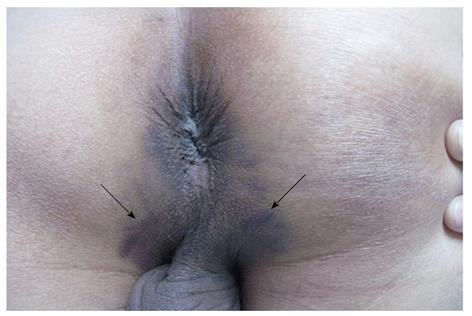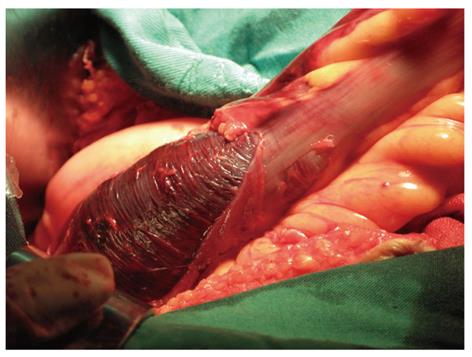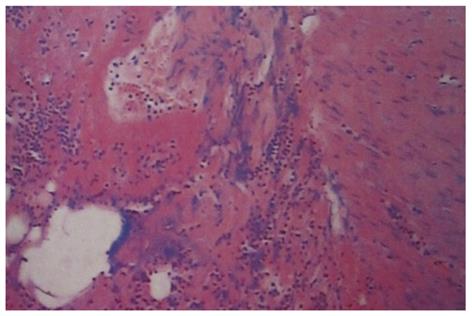Published online May 21, 2012. doi: 10.3748/wjg.v18.i19.2438
Revised: February 20, 2012
Accepted: February 26, 2012
Published online: May 21, 2012
Spontaneous hematomas are rare and most occur secondary to hematologic disorders or during anticoagulant therapy. Most spontaneous hematomas occur above the sigmoid colon, and rarely in the rectum. Herein we present the case of a patient with a spontaneous perforating hematoma of the rectum who presented with severe abdominal pain after a bloody stool. The hemoglobin level decreased by 33 g/L within 20 h. An abdominal sonogram showed a hydrops in the lower abdomen with a maximum depth of 7.0 cm. A hematoma, 8 cm × 6 cm × 5 cm in size, was noted intra-operatively in the rectosigmoid junction, with a 1.5-cm perforation in the hematoma and active hemorrhage. Thus, a partial rectectomy and sigmoidostomy were performed. Three months later, a second operative procedure to re-establish intestinal continuity was performed. The patient is in good condition 12 mo after the last surgery. In addition to this case, the causes of spontaneous perforating hematomas and the treatment are discussed.
- Citation: Li ZL, Wang ZJ, Han JG. Spontaneous perforation of an intramural rectal hematoma: Report of a case. World J Gastroenterol 2012; 18(19): 2438-2440
- URL: https://www.wjgnet.com/1007-9327/full/v18/i19/2438.htm
- DOI: https://dx.doi.org/10.3748/wjg.v18.i19.2438
Intramural hematomas may occur in every portion of the alimentary tract from the esophagus to the sigmoid colon, but rarely occur in the rectum. Intramural hematomas most often result from blunt trauma[1]. Non-traumatic spontaneous hematomas usually reflect an underlying blood dyscrasia, anticoagulant therapy, and hematologic diseases[2]. Spontaneous rectal hematomas have rarely been reported. Herein we present this unusual case of a spontaneous perforating hematoma.
A 52-year-old male was admitted to our hospital with a 20-h history of severe abdominal pain after passing a small amount of bloody stool. The patient had no history of trauma before admission and clearly related the acute onset of pain with straining to have a bowel movement. The patient had 5-year history of oral warfarin sodium use after mitral valve replacement and coronary stent implantation. The physical examination revealed diffuse abdominal tenderness, rebound tenderness, widespread perianal ecchymosis, and muscular tension without nausea and vomiting (Figure 1). There was a persistent drop in hemoglobin from 94 g/L to 61 g/L over a 20-h interval. The prothrombin time was prolonged (44.40 s; approximately four times the normal prothrombin time). An abdominal sonogram showed a large hydrops in the lower abdomen with a maximum depth of 7.0 cm. After admission, active resistance to shock treatment was given, and the abdominal symptoms did not remit, thus emergent surgery was performed. A palpable hematoma, 8 cm × 6 cm × 5 cm in size, was noted in the rectosigmoid junction intra-operatively (Figure 2). Furthermore, there was a perforation in the hematoma, 1.5 cm in diameter, and active hemorrhage. After confirming that the perforating hematoma of the rectum was the cause of the generalized peritonitis and the extensive oozing of blood could not be stopped, a partial rectectomy and sigmoidostomy were performed. A histopathologic examination of the removed specimen revealed extensive oozing of blood in the muscular layer of the rectum and fibrinoid necrosis within the vascular wall (Figure 3). The patient recovered without complications and was discharged on the 8th post-operative day. Three months later, the patient returned for re-establishment of intestinal continuity. The patient was in good health and completely asymptomatic during the 12-mo follow-up period after the second surgical procedure.
Intramural hematomas of the alimentary tract are unusual. Intramural hematomas mainly occur above the sigmoid colon, and rarely in the rectum. The duodenum is the most common site for intramural hematomas[1]. In a review of the medical literature, most rectal intramural hematomas occur following blunt trauma. Spontaneous perforating hematomas of the rectum have rarely been reported[3].
Of all intramural hematomas, 15%-36% are spontaneous in patients with underlying hematologic diseases or on anticoagulant therapy[2]. As shown in the current case, the patient had a long history of oral warfarin sodium use, and the prothrombin time was prolonged to 44.40 s, which is approximately four times the normal prothrombin time. Anticoagulation-induced intramural hematomas can occur in patients with therapeutic prothrombin times, but the majority of intramural hematomas occur in patients with abnormally prolonged prothrombin times[2]. Thus, anticoagulant therapy was thought to be closely related with the hematoma in this patient. In addition, increased abdominal pressure during straining may play an important role in hematoma formation. Specifically, when a patient strains to have a bowel movement, the abdominal pressure increases and the rectum contracts. The contracted rectum increases the intramural pressure which leads to decreased vascular compliance, and even rupture, thus causing a rectal intramural hematoma. When the pressure of the intramural hematoma is greater than the capacity of the hematoma wall, the hematoma breaks and clinical symptoms appear.
Most patients with intramural hematomas present with signs of intestinal obstruction[3]. Conservative therapy is usually sufficient because the hematomas will undergo spontaneous resorption[4], but treatment decisions depend on the symptoms and clinical findings[4,5]. Relief of the tamponade effect during conservative therapy could lead to further bleeding[1]. In patients in whom the cause of obstruction is not known, or in patients with complete obstruction or who have failed medical management, surgical intervention is required[6]. Draining the hematoma might increase the risk of serious infection, as reported previously[7]. According to the decreasing hemoglobin concentration and failed conservative therapy, we performed a partial rectectomy and sigmoidostomy. The patient recovered without complications.
Therefore, testing prothrombin times regularly and avoiding severe abdominal pressure in a patient who has a long-term oral anticoagulant drug history might help prevent complications associated with intramural hematomas, such as perforation.
Peer reviewers: Dr. Paulino Martínez Hernández Magro, Department of Colon and Rectal Surgery, Hospital San José de Celaya, Eje Vial Norponiente No 200-509, Colonia Villas de la Hacienda, 38010 Celaya, Mexico; Damian Casadesus Rodriguez, MD, PhD, Calixto Garcia University Hospital, J and University, Vedado, Havana City 999075, Cuba
S- Editor Gou SX L- Editor A E- Editor Zhang DN
| 1. | McClenathan JH, Dabadghav N. Blunt rectal trauma causing intramural rectal hematoma: report of a case. Dis Colon Rectum. 2004;47:380-382. [RCA] [PubMed] [DOI] [Full Text] [Cited by in Crossref: 4] [Cited by in RCA: 5] [Article Influence: 0.2] [Reference Citation Analysis (0)] |
| 2. | Hughes CE, Conn J, Sherman JO. Intramural hematoma of the gastrointestinal tract. Am J Surg. 1977;133:276-279. [RCA] [PubMed] [DOI] [Full Text] [Cited by in Crossref: 66] [Cited by in RCA: 54] [Article Influence: 1.1] [Reference Citation Analysis (0)] |
| 3. | TerKonda SP, Nichols FC, Sarr MG. Spontaneous perforating hematoma of the rectum. Report of a case. Dis Colon Rectum. 1992;35:270-272. [RCA] [PubMed] [DOI] [Full Text] [Cited by in Crossref: 5] [Cited by in RCA: 7] [Article Influence: 0.2] [Reference Citation Analysis (0)] |
| 4. | Zangan SM, Yousefzedah DK. Occlusive intraluminal hematoma. Pediatr Radiol. 2004;34:564-566. [RCA] [PubMed] [DOI] [Full Text] [Cited by in Crossref: 4] [Cited by in RCA: 5] [Article Influence: 0.2] [Reference Citation Analysis (0)] |
| 5. | Babu ED, Axisa B, Taghizadeh AK, Delicata RJ. Acute spontaneous haematoma of the rectum. Int J Clin Pract. 2001;55:66-67. [PubMed] |
| 6. | Battal B, Kocaoglu M, Ors F, Akgun V, Tasar M. Obstructive rectal intramural hematoma caused by a foreign body. Emerg Radiol. 2009;16:75-77. [RCA] [PubMed] [DOI] [Full Text] [Cited by in Crossref: 3] [Cited by in RCA: 4] [Article Influence: 0.2] [Reference Citation Analysis (1)] |
| 7. | Chen YM, Davis M, Ott DJ. Traumatic rectal hematoma following anal rape. Ann Emerg Med. 1986;15:850-852. [RCA] [PubMed] [DOI] [Full Text] [Cited by in Crossref: 6] [Cited by in RCA: 7] [Article Influence: 0.2] [Reference Citation Analysis (0)] |











